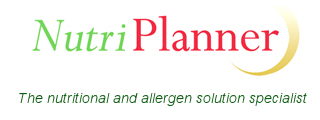The NutriPlanner “Zest” system is comprised of four primary “modules:
- Mise-en-place – meeting the core needs of any caterer
- Finance – features to address the business-side of the operation
- Landlord – tailored to provide management tools for the bar or hospitality houeskeeping operator
- Trakker – providing individual food diaries for any number of in-care clients
Mise-en-place
Mise-en-place provides the tools that most caterers need to plan, manage and control their menu provision.
In broad terms, recipes can be entered, menus assembled, costs, prices and margins checked and allergen and nutrition evaluated. More specifically…
- Recipes
- Set up your recipes, including preparation methods and photographs
- Instant checking of allergen and nutrient content
- Calculation of total cost vs price and margin
- Calculate ingredient amounts for any number ofportions
- Access to hundreds of “set” recipes for ideas
- Tools to quickly update all recipes with ingredient changes or price changes
- Compare ranges of recipes for nutrient or allergen content
- Organise your recipes in any way to suit your needs
- Menus
- Include any of your, or the “set” recipes into your menus
- Section your menus as you choose (e.g. starters, mains, etc.)
- Instantly check allergen or nutrient content
- Check menus against cost-centred or profit-centred goals
- Create menu cycles
- Evaluate menu cycles against nutrient targets or non-nutrient food standards
- Enter planned preparation quantities and actual consumption
- Calculate ingredient requirements from menu planned preparation quantities and pre-load a “shopping basket”
- Suppliers and ingredients
- Use the pre-loaded “set” ingredients or set up your own
- Enter your own ingredient costs, even against “set” ingredients
- Easy lookup tools to compare nutrient and allergen content
- Create “orders” for your suppliers from the “shopping basket” contents
- Stock control
- Enter your ingredient stock levels
- Keep track of ingredient expiration dates and storage location
- Automatically use stock, if available, when loading the “shopping basket”
- Check in deliveries from your suppliers, adding to stock
Finance
The Finance module provides extra tools to help manage the business side of the operation.
- Enter your receipts
- Record your supplier invoices and check them against orders
- Enter your overhead payments
- Maintain staff timesheets, calculate payments and automatically enter them into overhead payments
- Keep track of cash float
- Be VAT registered or not
- User reports to:
- Monitor unpaid bills and receipts
- Review your supplier trading history
- Check your trading and VAT summary
- Check your trail profit and loss
Landlord
The Landlord module provides a simple-to-use set of tools to keep track of non-food items that a bar or housekeeping operation would consume. The tools include:
- Setting up “consumption units”. These are combinations of any product that would used and consumed as a groups. For example a cocktail might include 3 or 4 separate products in various quantities.
- Consumption units are costed and can be priced with margin calculations
- Tariffs can be set up listing any number of consumption units
- Expected usage of each consumption unit can be entered and then a “shopping basket” loaded from the tariff
- Orders can be generated from the “shopping basket” and checked in after delivery
- Stock levels can be entered and automatically updated from usage and deliveries
- All data entered into Landlord is included the Finance module
Trakker
The Trakker module provides individual food diaries so that the nutrition of individuals can be recorded and evaluated. Depending on the subscription, any number of separate diaries can be maintained. The module includes:
- Easy set up of named food diaries
- Each diary has its own nutrient standards against which it can be evaluated
- Each diary can have specific allergen avoidance noted
- Entries into a diary can be any combination of:
- An amount of an ingredient
- A fraction of a portion of a recipe
- An option from that day’s menu (from Mise-en-place)
- An item not already included in the system as an ingredient
- Recipes can either be entered directly into Trakker or can be taken from those entered via Mise-en-place or the “Set” recipes in the system
- Entries into a diary are segmented into time of day, e.g. breakfast, snack, lunch, etc.
- Where a diary has allergen(s) noted against it, items containing those allergen(s) will be avoided when trying to add to a diary
- Diaries can be evaluated nutritionally across any time range
- An item can be added into several diaries in one operation
- Nutritional targets can be set up to suit a specific individual’s needs
Go to zest.nutriplanner.co.uk to find out (lots) more.
